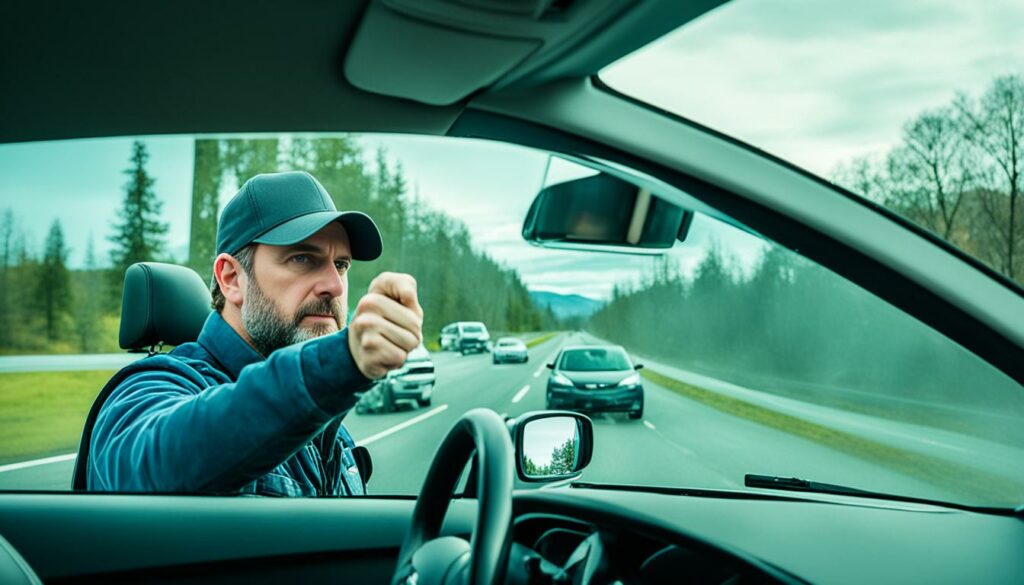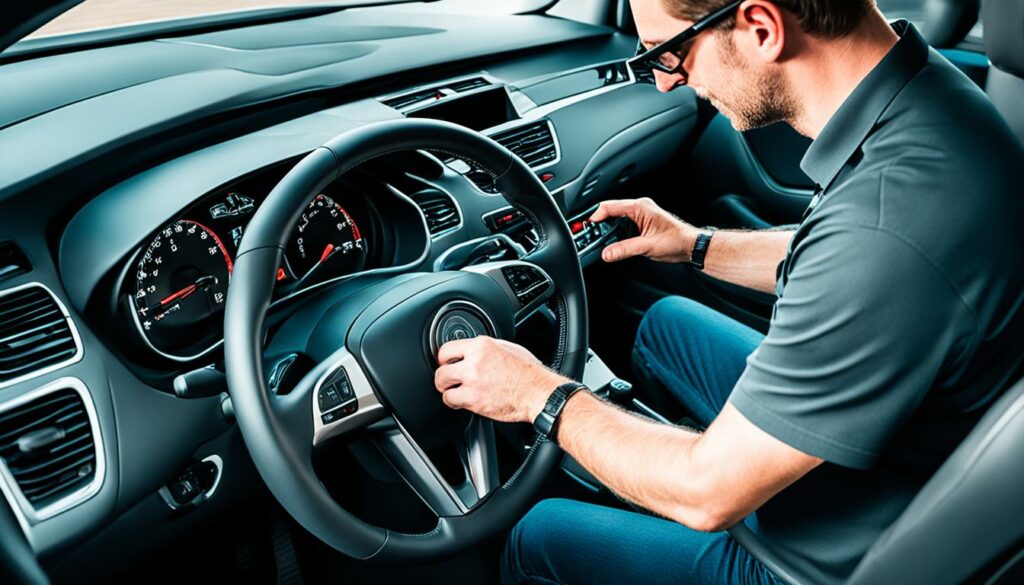Learning to Drive? Start with the Basics!
Learning how to drive can be an exciting and liberating experience. Whether you have never driven before or want to brush up on your skills, starting with the basics is essential. Do you know how to drive? If the answer is no, fear not! This article will provide you with the fundamental driving knowledge and skills you need to get started.
Before hitting the road, it’s crucial to begin practicing the driving basics while the car is safely parked. Start by adjusting the speed, wearing a seat belt, and familiarizing yourself with the vehicle’s controls. Properly adjusting the mirrors to minimize blind spots is also crucial for a clear view of the surroundings.
Are you ready to dive deeper into the world of driving? Let’s get started!
Key Takeaways:
- Learning to drive starts with mastering the basics and understanding the necessary driving techniques.
- Adjusting the mirrors properly is crucial to minimize blind spots and ensure a clear view on the roads.
- Practicing in a safe environment and familiarizing yourself with vehicle controls are essential steps in becoming a skilled driver.
- Building confidence and improving driving skills require structured training and practice.
- Take advantage of additional resources and support, such as driving lessons and learner driver downloads, to enhance your learning experience.
Creating a Learning Environment

When teaching someone to drive, it’s important to create a conducive learning environment that promotes focus and minimizes distractions. Here are some tips to help you establish the ideal setting for practice:
- Park the car in a safe environment: Choose a location where the learner can feel comfortable and at ease. For starters, your driveway or an empty parking lot can be excellent options.
- Limit distractions: Turn off the radio and minimize noise from mobile devices to ensure optimal concentration. This will allow the new driver to focus on the task at hand.
- Utilize tools for progress tracking: Consider using a Logging and Rating Tool to record each practice session. This can help the learner keep track of their progress and identify areas that need improvement. Additionally, a Goal Guide can provide clear objectives to work towards, making the learning process more structured.
- Teach the driving basics: Emphasize the importance of fundamental skills such as adjusting speed, wearing a seatbelt, and understanding the controls. These are the building blocks of safe and responsible driving.
Remember, learning to drive is a gradual process, and patience plays a crucial role in this journey. Don’t hesitate to seek guidance from video tutorials or instructional materials when needed.
Practice driving in a calm and focused environment to help new drivers build confidence and develop a solid foundation of driving skills.
Adjusting the Mirrors

One of the essential skills for any driver is knowing how to properly adjust the mirrors. Incorrect mirror adjustment can result in blind spots and compromised visibility, putting both the driver and other road users at risk. To ensure safety on the road, it’s crucial to teach new drivers the importance of proper mirror adjustment and the potential errors to avoid.
To start, have the new driver adjust the side mirrors to view a small portion of the car. The mirrors should be positioned to provide a clear view of the surrounding traffic. Additionally, the rearview mirror should be adjusted to provide a clear view of the back window.
Once the mirrors are adjusted, it’s essential to check their alignment by stepping outside the car. Ask the learner if they can see you in the mirrors, ensuring they have a clear view without any obstructions. If there are any blind spots or difficulties in seeing, make the necessary adjustments until the mirrors provide optimal visibility.
Common errors when adjusting mirrors include not having a clear view and having large blind spots. By emphasizing the correct mirror adjustment techniques, you can help new drivers develop good habits that contribute to safer driving experiences.
Proper Mirror Adjustment Checklist:
- Adjust side mirrors to view a small portion of the car
- Rearview mirror should provide a clear view of the back window
- Check alignment by viewing outside the car
- No blind spots or obstructions should be present
By ensuring proper mirror adjustment, new drivers can minimize blind spots and significantly improve their overall awareness of their surroundings, contributing to safer and more confident driving.
Statistics: Mirror Adjustment and Accidents
| Mirror Adjustment Issue | No. of Accidents Caused |
|---|---|
| Improper side mirror adjustment | 25% |
| Blind spots due to incorrect mirror alignment | 15% |
| Failure to check mirror adjustment regularly | 10% |
“Proper mirror adjustment is not just about convenience, it’s about safety. By taking a few extra seconds to align your mirrors correctly, you can significantly reduce the risk of accidents caused by blind spots and limited visibility.” – Driving Expert
Getting Familiar with Vehicle Controls

When learning to drive, it’s important to get familiar with the various vehicle controls. This section will guide you through adjusting the seat, foot pedals, mirrors, parking brake, gear stick, and dashboard controls, ensuring you have a comfortable and safe driving experience.
1. Adjusting the Seat
Before you start driving, it’s crucial to adjust the seat position so that both feet comfortably reach the pedals. A proper seating position not only ensures your comfort but also allows you to maintain control over the vehicle. Remember, you should be able to press the pedals without straining or stretching.
2. Foot Pedals
Next, familiarize yourself with the foot pedals – the accelerator and brake. The accelerator pedal, also known as the gas pedal, controls the speed of the vehicle. The brake pedal, as the name suggests, is used to slow down or bring the car to a stop. Understanding the function and sensitivity of these pedals is essential for smooth and controlled driving.
3. Adjusting the Mirrors
Properly adjusted mirrors are crucial for clear visibility while driving. Adjust the side mirrors so that a small portion of the car is visible. The rearview mirror should provide a clear view of the back window. Make sure to check the mirror adjustment by walking outside the car and ensuring you can see yourself in the mirrors. This will help eliminate blind spots and improve overall safety on the road.
4. Parking Brake
The parking brake is an important feature that helps secure the car in a stationary position when parked. It is typically located next to the driver’s seat, either as a lever or a button. Always engage the parking brake when you park your car, ensuring it doesn’t roll or move unexpectedly.
5. Gear Stick
If you’re driving a manual transmission car, it’s crucial to learn how to use the gear stick. The gear stick allows you to shift gears and control the gearbox, enabling you to match the engine’s power to the driving conditions. Familiarize yourself with the gear positions and practice shifting gears smoothly and efficiently.
6. Dashboard Controls
Lastly, take the time to familiarize yourself with the dashboard controls. These include important indicators such as the fuel gauge, speedometer, and temperature gauge. Understanding these controls will help you monitor your vehicle’s performance and ensure safe driving.
Now that you’ve become familiar with the various vehicle controls, you’re ready to take your first steps behind the wheel. Remember to always adjust the seat, foot pedals, mirrors, parking brake, gear stick, and be aware of the dashboard controls before you start your engine. This will ensure a comfortable and safe driving experience.
| Vehicle Controls | Main Function |
|---|---|
| Seat Adjustment | Provides comfort and control |
| Foot Pedals | Control vehicle speed and braking |
| Adjusting Mirrors | Improve visibility and eliminate blind spots |
| Parking Brake | Secure vehicle while parked |
| Gear Stick | Shift gears in manual cars |
| Dashboard Controls | Monitor vehicle performance |
Putting Safety First
Ensuring your safety and the safety of others should be your top priority when driving. By following a few simple guidelines, you can significantly reduce the risk of accidents and protect yourself on the road.
1. Always Put on Your Seatbelt
Before starting the car, make it a habit to buckle up your seatbelt. Seatbelts are one of the most effective safety devices in vehicles and can potentially save your life in the event of an accident. Remember, safety first!
2. Starting the Car Safely
When starting the car, keep your foot on the brake pedal to ensure the vehicle remains stationary. This will prevent any unwanted movement while you prepare to drive. If the vehicle has a parking brake, release it before you start moving.
3. Backing Out Safely
Before reversing out of a parking space or driveway, be sure to check your surroundings for any obstacles. Use your rearview and side mirrors to get a clear view of the area behind you. Remember, safety is about being aware of your surroundings.
4. Hands on the Steering Wheel
When driving, always keep both hands on the steering wheel. This is known as the “9 and 3 o’clock” hand position and provides optimal control of the vehicle. By maintaining a firm grip, you’ll be better prepared to handle any unexpected situations on the road.
5. Using Blinkers
One of the most crucial safety measures is using your vehicle’s blinkers to indicate your intentions. Whether you’re changing lanes or making a turn, using blinkers helps other drivers anticipate your actions and reduces the risk of collisions.
Remember, practicing safe driving habits is not only a legal requirement but also vital for your well-being and that of others on the road. By following these safety tips, you’ll be on the right path to becoming a responsible driver.
Starting to Drive

Now that you have mastered the basics of adjusting mirrors, understanding vehicle controls, and practicing in a safe environment, it’s time to put the car in drive and start moving forward. This is where the real excitement begins!
Come to a complete stop and put the car in “Drive” to engage the gears and prepare for movement. Remember to release the parking brake if it’s engaged.
Once you’re ready to go, gently press down on the accelerator pedal to accelerate. Start slow and gradually increase your speed as you become more comfortable behind the wheel. It’s important to maintain control and avoid sudden jerks or excessive acceleration.
As you move forward, keep both hands on the steering wheel and grip it firmly. This will allow you to have better control over the car’s movements and ensure a safe and steady drive.
When it’s time to make a turn, gently turn the steering wheel in the desired direction. Remember to use both hands and make smooth, controlled movements. Avoid jerking or oversteering, as it may affect your vehicle’s stability.
If you need to slow down or come to a stop, use the brake pedal. Apply gradual and consistent pressure to bring the car to a smooth stop. Remember, smooth braking is crucial for maintaining control and ensuring the safety of yourself and others on the road.
If you’re driving a manual transmission car, familiarize yourself with shifting gears. Shifting gears allows you to adjust the engine’s power and control your speed. Practice changing gears smoothly and at the appropriate times, depending on the road conditions and speed limit.
Remember, practice makes perfect. Take your time and focus on honing your driving skills. With each session, you’ll gain more confidence and become a more skilled and experienced driver.
So, put the car in drive, accelerate smoothly, steer confidently, use the brake when necessary, and familiarize yourself with shifting gears if applicable. You’re on your way to becoming a skilled driver!
Mastering Driving Skills
When it comes to becoming a skilled and confident driver, structured training is key. By taking driving lessons from a reputable instructor, you can enhance your skills and knowledge of the road. On average, it takes around 47 hours of lessons and 20 hours of practice to pass the driving test. However, with a well-structured training system, you can achieve success with just 30 hours of lessons.
Practice plays a crucial role in building confidence and mastering driving skills. The more you practice, the more comfortable and proficient you will become behind the wheel. It’s important to apply the techniques and principles learned during your driving lessons in real-world scenarios. From navigating traffic to parallel parking, each experience on the road will contribute to your growth as a driver.
If you want to further improve your knowledge and abilities, consider enrolling in an intermediate driving skills course. These courses are designed to provide additional training and guidance, giving you the opportunity to refine your skills in specific areas. Whether it’s improving your understanding of defensive driving or enhancing your ability to handle challenging road conditions, these courses can be invaluable.
“With focused training and regular practice, you can become a confident driver capable of passing the driving test and navigating the roads with ease.”
Remember, building confidence takes time and effort. It’s normal to feel nervous or uncertain when first starting out, but with each lesson and practice session, you’ll become more comfortable and skilled. Stay committed to your training, listen to your instructor’s guidance, and trust in your abilities. You have the potential to become a safe and competent driver.
Key Points:
- Structured driving lessons are essential for enhancing driving skills.
- Average time to pass the driving test is around 47 hours of lessons and 20 hours of practice.
- Structured training can help you pass the test with just 30 hours of lessons.
- Practice plays a vital role in building confidence and mastering driving skills.
- Consider taking an intermediate driving skills course to further improve your knowledge and abilities.
Additional Resources and Support
Enhance your driving lessons with free learner driver downloads to improve your driving skills. These resources provide valuable information and guidance, helping you make the most out of your practice sessions. Whether you’re looking for additional tips on maneuvering, parking, or understanding road signs, these downloads can supplement your driving lessons and equip you with the knowledge you need to become a confident and skilled driver.
Don’t keep these resources all to yourself! Share them with friends who are also learning to drive. By sharing these helpful materials, you can support and encourage each other’s progress on the journey toward becoming safe and competent drivers.
If you have specific topics or areas that you’d like to learn more about, don’t hesitate to reach out and send your suggestions. We value your feedback and aim to create resources that address your specific needs and questions.
While learner driver downloads can provide valuable supplementary material, it’s important to remember that they should not replace the expertise and guidance of a reputable driving instructor. Consider booking driving lessons with a professional instructor who can provide quality tuition and personalized feedback. With their support, you can further enhance your driving skills and increase your chances of passing your driving test with confidence.
Recommended Resources:
- Driving techniques and tips
- Common driving mistakes to avoid
- Traffic rules and road sign explanations
- Parallel parking and maneuvering guides
- Defensive driving strategies
| Resource | Description |
|---|---|
| Driving Techniques and Tips | Learn advanced driving techniques and useful tips to improve your overall driving skills and confidence on the road. |
| Common Driving Mistakes to Avoid | Identify and overcome common driving mistakes that new drivers often make. By understanding these mistakes, you can become a safer and more aware driver. |
| Traffic Rules and Road Sign Explanations | Get a comprehensive guide to traffic rules and road signs, including explanations and illustrations that will help you navigate the roads with ease. |
| Parallel Parking and Maneuvering Guides | Master the art of parallel parking and learn essential maneuvering techniques with step-by-step guides and helpful visuals. |
| Defensive Driving Strategies | Discover defensive driving techniques that will help you anticipate and respond to potential hazards on the road, ensuring your safety and the safety of others. |
Conclusion
Mastering driving skills and improving your abilities on the road is a journey that starts with learning the basics. By adjusting mirrors, understanding vehicle controls, and practicing in a safe environment, you lay a strong foundation for your driving journey.
However, building confidence and becoming a skilled driver requires more than just the basics. Structured training and regular practice are essential to enhance your driving skills and ensure a thorough understanding of traffic rules and regulations.
Don’t hesitate to take advantage of additional resources and support available to you. Utilize learner driver downloads and consider booking driving lessons with a reputable instructor to supplement your learning experience. With dedication, proper guidance, and continuous effort, you can improve your driving abilities and become a knowledgeable driver on the road.
So, get ready to embark on this exciting journey. Explore new techniques, deepen your understanding of traffic rules, and refine your driving skills. Remember, with each practice session, you are one step closer to becoming a confident driver. Safe travels!







